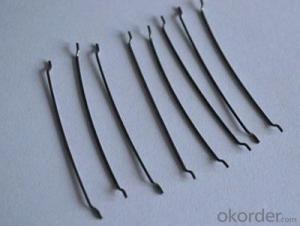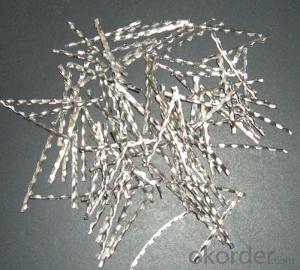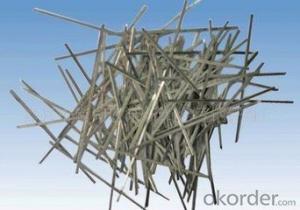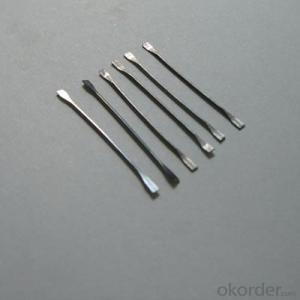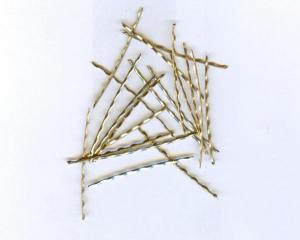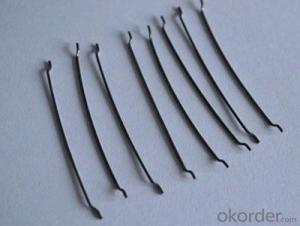Steel Fiber Straight Type From CNBM International
- Loading Port:
- Tianjin
- Payment Terms:
- TT OR LC
- Min Order Qty:
- 1000 kg
- Supply Capability:
- 30000 kg/month
OKorder Service Pledge
OKorder Financial Service
You Might Also Like
Quick Details
Place of Origin: Jiangsu, China (Mainland)
Model Number: HT-ST
Material: Steel
Specifications
ISO 9001 certificated
2.70% for Europe, Middle Asia, America market
3.Have the most number of steel fiber machine in china
1. Material: low carbon steel wire or stainless steel
2.Diameter: 0.4mm-1.0mm
3.Length: meet your requirements
4.tensile strength >1000Mpa
6.Feature: excellent tensile,high tenacity,against cracking,impact and fatigue
7.Uses: highway road surface,tunnel,building,airport road surface and so on .
Straight Steel Fiber
1.ISO 9001 certificated
2.70% for Europe, Middle Asia, America market
3.Have the most number of steel fiber machine in china
Picture
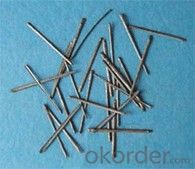
Steel fiber straight type
FAQ
certificated: ISO 9001
Technical advantages of Daye steel fiber:
A. Improve mechanical performance of concrete
B. Provide uniform distribution throughout concrete with excellent mixing
C. No balling or caking by adopt correct mixing method
D. Reduce concrete volume
E.Save construction time and cost
F.Reduce excavation volume
G.Available for jointless floor.
- Q:What is the recommended curing regime when using melt extract stainless steel fiber in concrete?
- The recommended curing regime when using melt extract stainless steel fiber in concrete typically involves a standard curing process similar to regular concrete. This includes keeping the concrete moist and at a consistent temperature for a certain period of time to allow for proper hydration and curing. Specifically, it is generally recommended to follow the ACI (American Concrete Institute) guidelines for curing concrete. This involves initial moist curing for a minimum of 7 days, where the concrete should be kept moist by continuously spraying or covering it with wet burlap, plastic sheeting, or similar materials. This helps prevent moisture loss and allows for optimal curing. After the initial moist curing period, it is recommended to continue curing the concrete for an additional 14 days at a minimum, either by keeping it moist or by applying a curing compound. Curing compounds are liquid coatings that are applied to the concrete surface to form a barrier that prevents moisture loss. These compounds provide a protective layer that helps to retain moisture within the concrete and promote proper curing. It is important to note that the specific curing regime may vary depending on the project requirements, environmental conditions, and the specific manufacturer's recommendations for the melt extract stainless steel fiber being used in the concrete. Therefore, it is always advisable to consult the manufacturer's technical data sheets or seek guidance from experienced professionals to ensure the correct curing regime is followed for optimal performance of the concrete incorporating melt extract stainless steel fiber.
- Q:What is the average length of melt extract stainless steel fiber?
- The specific application and manufacturing process often determine the average length of melt extract stainless steel fiber. Generally, this fiber ranges from a few millimeters to a few centimeters, which is ideal for improving the mechanical properties and durability of materials like concrete, composites, and refractories. It is important to mention that manufacturers can provide various lengths of melt extract stainless steel fiber to meet the specific requirements and preferences of their customers.
- Q:What is the effect of melt extract stainless steel fiber on the crack propagation in concrete?
- The primary effect of melt extract stainless steel fiber on crack propagation in concrete is to enhance crack resistance and improve the overall durability of concrete structures. When stainless steel fibers are incorporated into concrete, they create a three-dimensional reinforcement network that promotes a more even distribution of stress throughout the concrete matrix. By dispersing the load and reducing stress concentration at vulnerable points like cracks or weak zones, the stainless steel fibers effectively hinder crack propagation. Acting as micro-reinforcements within the concrete, these fibers bridge cracks and prevent them from spreading further. Stainless steel fibers possess unique properties such as high tensile strength, corrosion resistance, and ductility, which make them particularly effective in boosting concrete's crack resistance. Unlike other fiber types, stainless steel fibers can withstand high tensile stresses and maintain their integrity even in extreme conditions like freeze-thaw cycles or exposure to chemicals. Moreover, the manufacturing process of melt extract stainless steel fibers ensures a high aspect ratio, providing a large surface area for interaction with the surrounding concrete matrix. This increased bond between the fibers and the concrete matrix further enhances crack resistance. Overall, the inclusion of melt extract stainless steel fibers in concrete significantly improves its ability to resist cracking and enhances its durability. Consequently, this leads to extended service life, reduced maintenance expenses, and enhanced safety for concrete structures in various applications such as buildings, bridges, pavements, and tunnels.
- Q:How does melt extract stainless steel fiber enhance the fatigue resistance of concrete?
- Melt extract stainless steel fiber enhances the fatigue resistance of concrete by increasing its toughness and durability. The fibers act as reinforcement, improving the concrete's ability to withstand repeated loading and reducing the formation and propagation of cracks. This results in a stronger and more resilient concrete structure that can withstand cyclic loading without experiencing fatigue failure.
- Q:What is the effect of melt extract stainless steel fiber on the impact strength of shotcrete?
- The addition of melt extract stainless steel fiber to shotcrete generally improves its impact strength. This is because the fiber reinforces the shotcrete matrix, enhancing its ability to resist cracking and withstand impact forces.
- Q:How does melt extract stainless steel fiber improve the fatigue resistance of concrete?
- Melt extract stainless steel fiber improves the fatigue resistance of concrete by enhancing its strength and durability. The fibers act as reinforcement within the concrete matrix, distributing and dissipating stress more effectively. This reduces the formation and propagation of cracks, increasing the overall fatigue life of the concrete. Additionally, the high tensile strength and corrosion resistance of stainless steel fibers provide long-term structural stability, making the concrete less prone to failure under cyclic loading conditions.
- Q:How does the size and shape of melt extract stainless steel fiber affect its performance?
- The performance of melt extract stainless steel fiber is greatly influenced by its size and shape in different applications. Firstly, the fiber's surface area and volume are impacted by its size, which in turn affects its bonding strength with other materials. Smaller fibers generally have a larger surface area, allowing for stronger adhesion and better reinforcement of composite materials. Furthermore, the fiber's mechanical properties, such as tensile strength and ductility, are also influenced by its size. Smaller fibers tend to have higher tensile strength and increased flexibility, making them suitable for applications requiring improved structural integrity and resistance to deformation. Additionally, the performance of melt extract stainless steel fiber is dependent on its shape. Fibers with irregular or jagged shapes exhibit enhanced interlocking capabilities, enabling them to provide better mechanical anchorage within the matrix material. This improved interlocking mechanism enhances the fiber's ability to distribute stress and resist crack propagation, thereby increasing the overall durability and toughness of the composite material. On the other hand, fibers with a more regular or smooth shape offer advantages in terms of flowability and dispersibility during the manufacturing process. These fibers tend to exhibit better homogeneity and uniform distribution within the matrix material, resulting in improved mechanical properties and overall performance. In conclusion, the performance of melt extract stainless steel fibers is significantly influenced by their size and shape. Manufacturers can optimize the fiber's bonding strength, mechanical properties, and overall effectiveness in various applications, such as reinforcement in concrete, thermal insulation, or electrical conductivity, by carefully selecting the appropriate size and shape.
- Q:Can melt extract stainless steel fiber reduce the risk of spalling in high-strength concrete?
- The inclusion of melt extract stainless steel fibers in high-strength concrete is beneficial for preventing spalling. Spalling is a common issue in high-strength concrete, especially when it is exposed to high temperatures or fire. The utilization of stainless steel fibers enhances the concrete's capacity to withstand thermal stresses and prevents spalling. Stainless steel fibers possess exceptional mechanical properties, such as high tensile strength and corrosion resistance. These fibers reinforce the concrete matrix and enhance its overall durability when incorporated into high-strength concrete. They act as a reinforcement, evenly distributing the load and minimizing the risk of cracking and spalling. The unique characteristics of melt extract stainless steel fibers make them highly effective in preventing spalling. These fibers are typically very fine with diameters ranging from 0.1 to 0.3 mm. This allows for easy dispersion and even distribution throughout the concrete mixture, effectively reinforcing the entire structure. Furthermore, stainless steel fibers have a high melting point and excellent thermal conductivity. When exposed to high temperatures, the fibers dissipate heat and decrease the thermal gradients within the concrete. This prevents the formation of internal stresses that can result in spalling. In conclusion, the addition of melt extract stainless steel fibers to high-strength concrete significantly reduces the risk of spalling. These fibers reinforce the matrix, enhance its resistance to cracking, and improve its ability to withstand thermal stresses. By preventing spalling, the concrete's structural integrity and longevity are improved, resulting in a safer and more durable material.
- Q:Can melt extract stainless steel fiber reduce the risk of early-age cracking in concrete?
- The inclusion of melt extract stainless steel fibers in the concrete mix can effectively mitigate the occurrence of early-age cracking. Shrinkage, temperature fluctuations, and insufficient tensile strength are common factors contributing to such cracking. The addition of these fibers enhances the overall tensile strength of the concrete, acting as a reinforcement that effectively disperses stresses and hinders the initiation and spread of cracks. Furthermore, these stainless steel fibers aid in controlling concrete shrinkage by diminishing the size of cracks, both in width and length. This subsequently minimizes the risk of early-age cracking and enhances the longevity and durability of the concrete structure.
- Q:Does melt extract stainless steel fiber improve the fire resistance of concrete?
- Yes, melt extract stainless steel fiber does improve the fire resistance of concrete. When added to concrete, stainless steel fibers act as reinforcement, enhancing the strength and durability of the material. During a fire, these fibers help to slow down the spread of heat and prevent the concrete from cracking or spalling. Additionally, the high melting point of stainless steel ensures that it retains its structural integrity even under extreme temperatures. This improves the overall fire resistance of the concrete, making it a more reliable and safe construction material in fire-prone areas.
1. Manufacturer Overview |
|
|---|---|
| Location | |
| Year Established | |
| Annual Output Value | |
| Main Markets | |
| Company Certifications | |
2. Manufacturer Certificates |
|
|---|---|
| a) Certification Name | |
| Range | |
| Reference | |
| Validity Period | |
3. Manufacturer Capability |
|
|---|---|
| a)Trade Capacity | |
| Nearest Port | |
| Export Percentage | |
| No.of Employees in Trade Department | |
| Language Spoken: | |
| b)Factory Information | |
| Factory Size: | |
| No. of Production Lines | |
| Contract Manufacturing | |
| Product Price Range | |
Send your message to us
Steel Fiber Straight Type From CNBM International
- Loading Port:
- Tianjin
- Payment Terms:
- TT OR LC
- Min Order Qty:
- 1000 kg
- Supply Capability:
- 30000 kg/month
OKorder Service Pledge
OKorder Financial Service
Similar products
New products
Hot products
Related keywords
